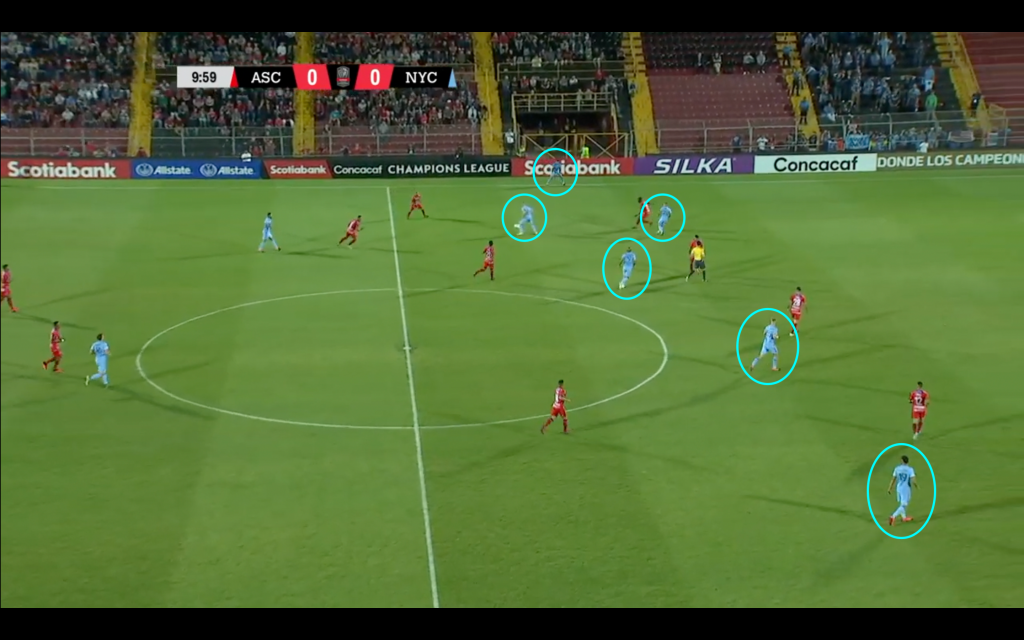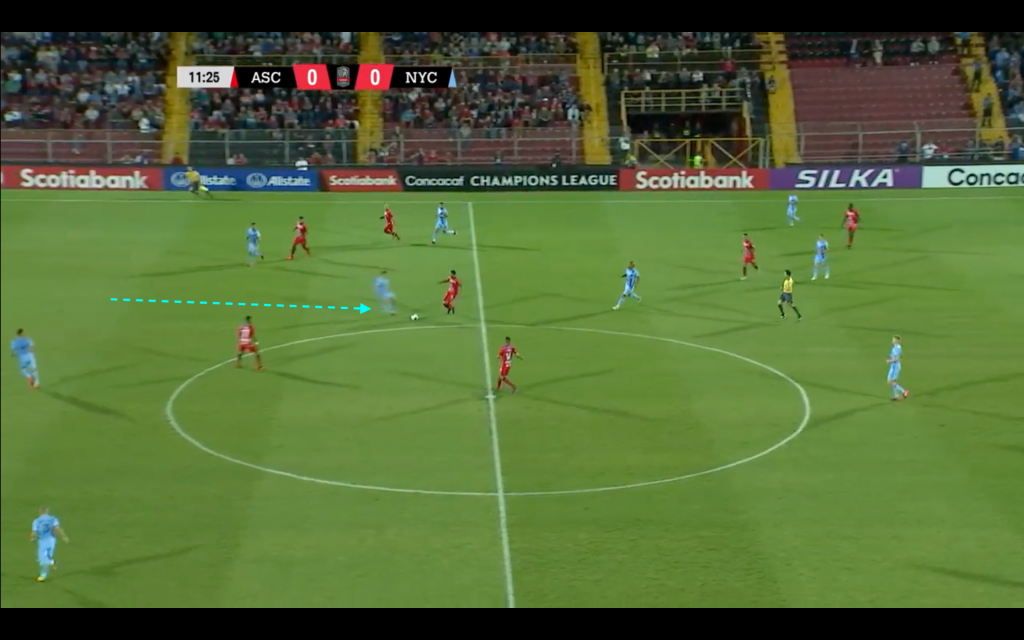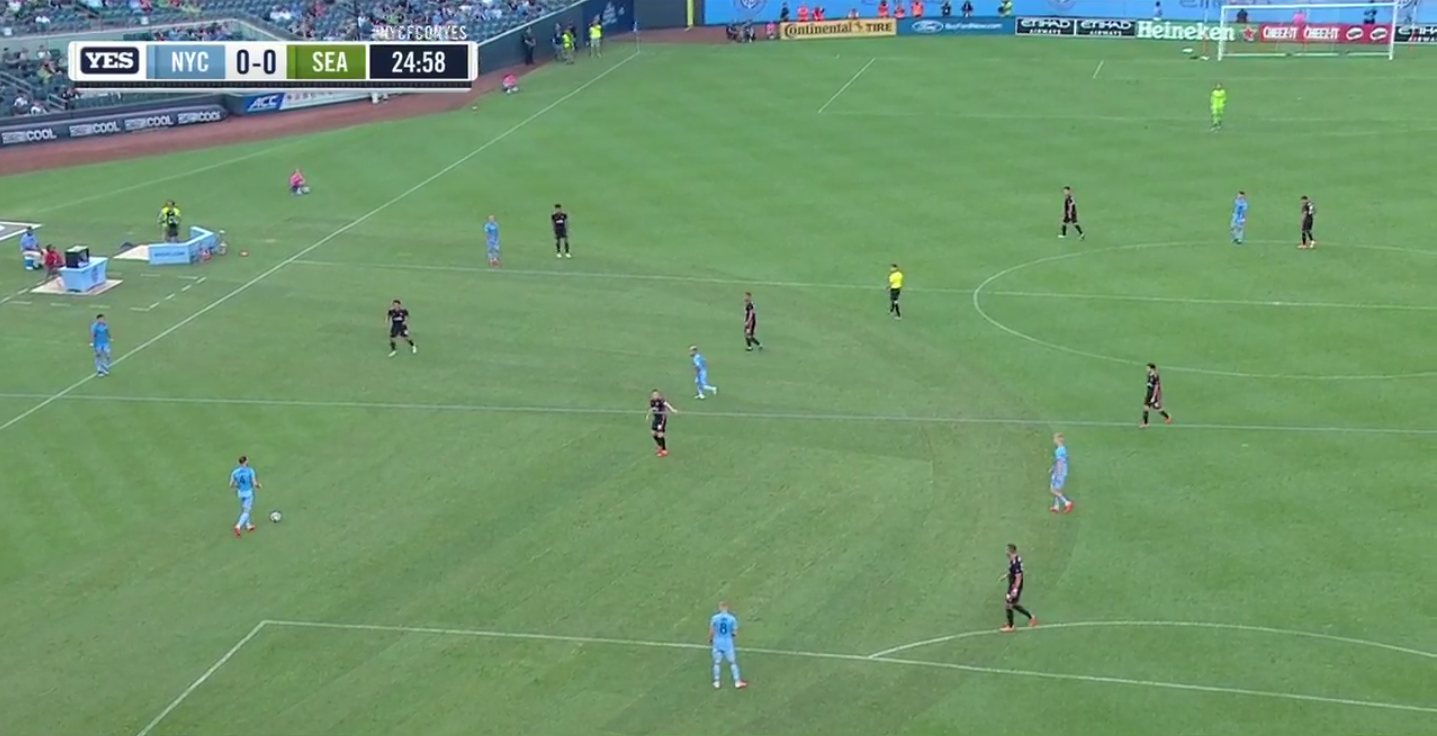NYCFC’s CEO on transparency, ambition, and what he’s learned in a year on the job.
Of all the things New York City FC is known for, it’s safe to say openness and communication aren’t what your corporate exec types might call “top of mind.” Like a lot of soccer outlets, The Outfield’s occasional efforts to pull interesting quotes out of this club have felt like dental surgery with rusty pliers, and like a lot of soccer outlets those efforts have sometimes ended with us getting ghosted by NYCFC’s comms department.
So it was a pleasant surprise to eat bagels around a conference table in NYCFC’s office this morning while the club’s still newish CEO, Brad Sims, held forth to the usual local media suspects on the coming season. I’d braved Grand Central at rush hour because lately Sims has been making noise about communicating better with fans and media, and I wanted to sit down with him one-on-one to find out whether we’re really seeing the dawn of some kind of City Football Glasnost.
Our conversation is below, lightly edited for length and clarity.
You said in a recent Q&A that communicating more with fans was your New Year’s resolution, and true to your word we’ve seen more of that from the front office in the last month. Is this a new era of transparency from NYCFC? Why now?
So, first, yes. I’m excited about it. I really want to focus more on it going forward. I’ve been on the job twelve, thirteen months or so and I’ve heard about how things may have been in the past, but for me all I have to go on is the last year-plus. Looking back at the last year, I don’t feel like in 2019 I communicated as much as I should have or needed to with fans. I had some feedback about that and I think it was fair feedback, so that is something that is more of a focus.
I think that generally I was really hyperfocused internally, in our house, in 2019. And I still need to do that in 2020, there’s still work to be done, but I think it’s important to be more externally facing. Myself and then we’ve had—whether it’s our coach, our sporting director Dave Lee, and now Matt Goodman, coming on, has done a number of things. That’s a huge focus across the senior level of the organization going forward.
On Thursday night you told a reporter that “the reality going back five years” on the stadium was that “we can’t legally announce something until there’s contracts signed by all the parties.” On Friday the New York Times published a stadium story and by Saturday you were emailing fans to fill them in on the stadium situation. What happened to the legal obstacles in those 36 hours?
I think my intentions were to say, in most situations, we won’t announce things that aren’t signed. Two recent examples are the CCL venue and the Citi Field series. Going back to Citi Field, I heard some feedback from people saying, “Why are you announcing this now in December? This is a bait and switch.” Most people were very positive about it, but the people that were saying that—we literally did not have the discussions and plans until two weeks before. We were negotiating the contract. When we signed the contract with the Mets, we literally announced two hours later.
Is that a PR strategy or is that a legal obstacle?
No, so that—it’s two things. Sometimes it’s legal and sometimes it’s negotiating leverage.
So what changed on Friday, was that a negotiating leverage point or a legal obstacle that was cleared?
The primary thing was negotiation. One thing I said on Thursday night was that we were still exploring other opportunities, which is true, we were attempting a hail mary option at that point in time. And the other thing is there were some important deal points that we needed to have in that deal that at that point, on that night, had not been agreed upon, and we felt that if we said anything specific it would put us in a much worse position. The next morning we got to a point where things were negotiated to our satisfaction—well, relatively speaking—and from the time we signed a contract, within thirty minutes we had an announcement out there.
Have you been happy with the feedback that you got on that email?
On Saturday?
Yeah, what you sent out to fans this weekend.
On the stadium? Yeah, I probably had fifteen, twenty emails, LinkedIn messages, responses from fans that they were appreciative of it. Other feedback has been positive. Emails to our staff, social media, things like that, I think it’s been positive.
City Football Group has privately expressed concern that NYCFC’s stadium search could expose it to criticism for Abu Dhabi’s politics on, quote, “gay, wealth, women, Israel.” Has NYCFC’s ownership kept the club from being more transparent with its city and fans?
As it pertains to UAE, that’s not something I can comment on. I’m not familiar with that quote or anything that you said, and I’m not an official spokesperson for UAE. All I can talk about is NYCFC and my role, and from that standpoint, all I’ve seen from our organization here in New York and in Manchester and in other markets, I’ve seen nothing but incredible amounts of support and resources from our ownership group, from CFG, into local communities and City in the Community, our nonprofit group. It’s been unbelievable the amount of resources and support that they have put toward that.
Have they had any influence on the club’s lowkey media strategy on the stadium?
They’re not—really we drive all the decisionmaking here locally. We consult probably a little bit but none of our policies or business operations are top-down driven. I think that we utilize our CFG resources appropriately, because they’re great resources. We have talented people. Our global CMO in Manchester and our VP of Marketing here talk regularly, because our global CMO is really smart and has a ton of good ideas and resources and can be helpful. Same with all of our other departments. Sam [Cooke, NYCFC’s Head of Communications] has a similar relationship with the global Head of Comms; our head of finance with the global CFO; and Dave Lee, our sporting director, with the global Head of Football. They’re great resources for us, but ultimately decisions are made here in New York across the board, on business strategy and sporting.
Speaking of the sporting side, in its first season, NYCFC signed global superstars like David Villa for what it called “one of the most ambitious projects in MLS history.” Last year the club sank below the median MLS payroll. What happened to that ambitious project, and why should New Yorkers accept an uber-wealthy team settling for low-budget efficiency?
Well, I don’t know that we’re settling. We had the best record in the Eastern Conference last year. It was the best club we’ve ever had, the most goals we’ve ever scored, the first time we’ve qualified for the Champions League. So if that’s settling, bring it on, we’ll settle some more.
The reality is, I think we’ve gotten, as an organization, smarter, and have found better ways to team-build. That’s not anything I can take any credit for, but I think we have really smart people in our sporting department and great resources from CFG. That’s probably our biggest advantage against other MLS clubs: we’re finding players like Héber and Mitriță that no other club really knew existed, and they’re being every bit as impactful or more impactful than some aging big name star player.
It was a good season but the club lost in the first round of the playoffs. It could have been a historic season with somebody like Carlos Vela in Jesús Medina’s wasted DP slot. Why are you satisfied with good enough?
We’re not satisfied with good enough, and that’s why our ambition is to hoist a trophy this year. We have four opportunities to hoist trophies this year.
Can you do that when all three of your DPs aren’t on the field?
Sure. I mean, we could have done it—just because we didn’t have a third DP isn’t the reason why we lost a playoff game. The playoff system is a cruel system. It was a different system last year, the first time it’d been kind of a knockout round versus being two legs. Anything could happen. You could have players that get injured, you could have players that pick up a bad foul, you could have a bad call, you could have one bad 45 minutes, one bad one minute, and that could be the difference in a match. And it doesn’t mean that our roster construction was flawed.
I mean, one of your Designated Players, Jesús Medina, wasn’t even on the bench in the playoffs. That’s a problem, right, in MLS, when you only have three Designated Player slots?
Well, I think that ideally every player on the roster is playing at or above your expectations. You can make the same argument for player number nine, if they are way worse than every other team’s player number nine. I think that for us, ideally, you want to maximize every roster spot. There are challenges and complications around the rules in MLS. There’s the salary cap, and obviously like you pointed out there’s a number of DP slots. Ultimately we’re trying to construct the best roster we can, and we feel great about it.
After NYCFC finished first in the East, the founding sporting director and most successful coach in club history both quit, signaling problems in the organization. Why did Claudio Reyna and Dome Torrent leave, and what will NYCFC do differently to retain talent in the future?
I can’t speak for Claudio or Dome. You’re welcome to contact them and ask them.
What I can say specifically to Claudio’s situation is he’s got a great opportunity. He built this club. He was the first team member here and he built the sporting department from scratch. Those kind of opportunities, to start a club, or to build a stadium or arena—there’s certain transformational opportunities, in this industry, that don’t come along very often. Most people go their entire careers without being a part of them.
That’s something that’s attractive to me about this job. In prior jobs I’ve built stadiums and arenas. Starting a team from scratch, that’s one thing I haven’t done, personally, on the business side. I know people who have and it’s one of the most rewarding experiences that anyone can have in this industry. Claudio did it here and he’s got a chance to do it in Austin. Austin’s set up to be an amazing success, I think, from a business standpoint, and they’ve got a great person to run the sporting side.
So we’re—I don’t want to say happy for Claudio, because Claudio did a great job here, but we’re happy that he’s found a challenge that he’s excited about as his next career step. Having two of those projects in a career is something almost nobody on the sports side or the business side, regardless of the sport, I don’t know of anyone who’s started two teams from scratch. It’s an amazing opportunity.
And Dome leaving with no job lined up, that doesn’t worry you, that somebody would want to leave this club that badly?
Again, it’s just speculation from my standpoint. Personally I had a really good relationship with Dome. Dome had a number of challenges, I think, with the league and with other areas that were well documented. I’m not going to speak for him. But he’s done very well in his career, and he felt like he was ready for a change.
For us, what’s really important is having people who are really dedicated to the club and want to be here. I think that way whether it’s an entry-level ticket salesperson, a VP of Marketing, an academy coach, or a head coach. We want people who are dedicated to this club, who really want to be here and want to be a part of this. That wasn’t the case, for whatever reason, with Dome, but it is the case with Ronny [Deila].
I mean, Ronny couldn’t be more thrilled to be part of this organization. When we went through the coaching search, that was a key piece. There’s all these big names—people opine, like, go get this guy or go get this guy, but we didn’t want someone where this job was settling for them, or just a placeholder until they could get their next job. We wanted someone who really saw the opportunity here, saw the type of club we had, the type of team we had, how well positioned we were, and that wanted to be in New York, wanted to be in MLS, wanted to be at NYCFC and bring championships to us. That was super important.
So Ronny Deila’s happy to be here, possibly because he comes here from a team in the bottom half of the Norwegian league that got worse in three seasons under him. Why does NYCFC think he’s qualified to improve on Patrick Vieira and Dome Torrent’s teams?
I would say a couple things. One is look at the full story. You can look at anyone’s career at any point—if you look at a salesperson’s last two weeks and they had a bad last two weeks and you say why should we keep that person on—
Last three years, though?
Well, he’s had a career that’s longer than three years, and he’s lifted lots of trophies. One of the things that’s important for us is someone who’s actually coached winning teams, has won trophies. That was important for our head coach and also our top assistant that we announced recently, Nick Cushing, from Man City Women. Again, same kind of great reputation with players, has lifted many trophies. We believe we have a team that’s ready to take that next step, so we wanted someone who has been a part of that, which Ronny has been many times and Nick has been many times.
Again, we want people that really want to be here and people that understand and want to play a similar style of play. That’s the core of the DNA of NYCFC—and City Football Group, for that matter—having people who have a strong familiarity with our system and our organization, which Ronny does, Nick obviously does, and Dome and Patrick did. We’ve found it’s been important to have people familiar with our organization and the way we play.
How many coaches were interviewed for that position?
Oh, our vetting process was unbelievable. I was in Manchester shortly after that process. We vetted hundreds of coaches and we interviewed many. I won’t give an exact number, but we interviewed many. Our shortlist was four or five after the initial round of interviews, the initial round of vetting based on lots of factors we felt were important. It took a while because it was a very thorough process.
All right, last question. You spent your first year at NYCFC on a “listening tour.” What did you learn about this club that you didn’t know when you took the job?
Good question. One thing I didn’t know was the level of passion of not only our biggest fans, but also our team members. A passion for the club but also growing the sport. I’ve spent 24 years now in the sports industry, been very fortunate to have spent my whole career in this industry. I’ve worked in baseball, basketball, hockey. Major leagues, minor leagues. I’ve been in the league office, I’ve been on the team side. This was my first foray into soccer, and that’s what stood out to me.
In addition to seeing NYCFC do well and win, I think people want to see the sport of soccer elevated and grown in this city and in this country. Our mission statement is building New York City into one of the soccer capitals of the world. I feel like we have that opportunity in New York City, the greatest city in the world, in a country where soccer is going on a very steep upward trajectory. We have an awesome opportunity and, quite frankly, really, responsibility.
None of that was really on the top of my mind when I took the job. On the top of my mind when I took the job was: We’ve got to increase attendance. We’ve got to increase partnership revenue. We’ve got to, you know, connect with the fanbase. But it became pretty clear to me pretty early on that this is next level stuff. Which is really exciting and refreshing.
Now obviously passion can go the other way, too. And that’s going to mean that I’m going to be—me personally and our organization—criticized, and I get that, I appreciate it. I have thick skin, so I can deal with it. I don’t take things personally because ultimately I know it’s coming from a place of passion. Our fans love this club and they love this sport and they have high expectations. For me, it’s a great opportunity and responsibility to lift this whole thing to a place where everyone feels great about it. It’s not easy, it hasn’t been easy, it’s not going to be easy. But I like a good challenge, so I’m having a lot of fun. ❧
Image: Irving Penn, Mouth (for L’Oreal)


















